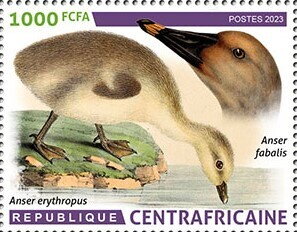Stamp: Lesser white-fronted goose - Bean goose (Central African Republic 2023)
Lesser white-fronted goose - Bean goose (Central African Republic 2023)
20 June (Central African Republic ) within release Birds (2023) goes into circulation Stamp Lesser white-fronted goose - Bean goose face value 1,000 Central African CFA franc
| Stamp Lesser white-fronted goose - Bean goose in catalogues | |
|---|---|
| Yvert et Tellier: | Yt: CF 10642 |
Stamp is square format.
Also in the issue Birds (2023):
- Mini Sheet - Baby Birds face value 4*1000;
- Souvenir Sheet - Morus bassanus face value 3,600;
- Stamp - Eurasian chaffinch (Fringilla coelebs) face value 1,000;
- Stamp - Lesser white-fronted goose - Bean goose face value 1,000;
- Stamp - Turkestan ground jay (Podoces panderi) face value 1,000;
- Stamp - Western capercaillie (Tetrao urogallus) face value 1,000;
Stamp Lesser white-fronted goose - Bean goose it reflects the thematic directions:
Animals are multicellular, eukaryotic organisms of the kingdom Animalia (also called Metazoa). All animals are motile, meaning they can move spontaneously and independently, at some point in their lives. Their body plan eventually becomes fixed as they develop, although some undergo a process of metamorphosis later on in their lives. All animals are heterotrophs: they must ingest other organisms or their products for sustenance.
Birds (Aves), a subgroup of Reptiles, are the last living examples of Dinosaurs. They are a group of endothermic vertebrates, characterised by feathers, toothless beaked jaws, the laying of hard-shelled eggs, a high metabolic rate, a four-chambered heart, and a strong yet lightweight skeleton. Birds live worldwide and range in size from the 5 cm (2 in) bee hummingbird to the 2.75 m (9 ft) ostrich. They rank as the class of tetrapods with the most living species, at approximately ten thousand, with more than half of these being passerines, sometimes known as perching birds. Birds are the closest living relatives of crocodilians.
A juvenile is an individual organism (especially an animal) that has not yet reached its adult form, sexual maturity or size. Juveniles can look very different from the adult form, particularly in colour, and may not fill the same niche as the adult form. In many organisms the juvenile has a different name from the adult (see List of animal names).



